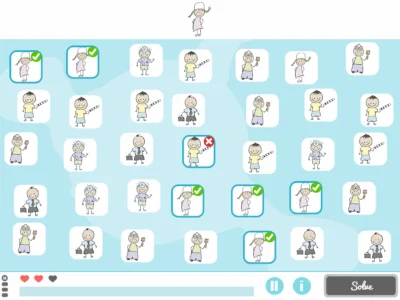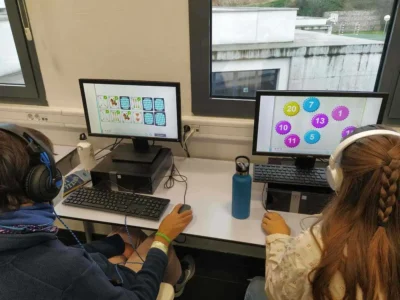Psychologist Carlos Rebolleda presents in this article several therapies for cognitive treatment in schizophrenia.
Schizophrenia requires ongoing treatment even after symptoms have disappeared. Over recent years, there have been multiple programs aimed at treating deficits in social cognition that commonly occur in schizophrenia and that, in turn, have been scientifically validated. In this related article, some of them will be reviewed.
Affect Recognition Training
According to Durá et al. (2008) Affect Recognition Training (TAR) (Frommann et al., 2003; Wölwer et al., 2005) is a standardized, computerized training for recognizing facial expression.
The program comprises 3 blocks with 4 sessions per block, with a duration of approximately 45 minutes per session and a total of 12 sessions. It is conducted in pairs of patients under the guidance of the psychotherapist. The tasks presented progressively increase in difficulty:
- In the first block patients learn to identify and discriminate, as well as verbalize, the main facial signs of the 6 basic emotions. The question they are asked is “what affect does this person express?”.
- In the second block, an attempt is made to integrate this detailed view of affect into an increasingly global mode of processing, based on first impressions, non-verbal processing and processing of low-intensity facial expressions. The task they must perform is “Classify the photos according to the intensity of the facial affect”.
- The third block comprises, on the one hand, the processing of non-prototypical and ambiguous affective expressions, which often occur in daily life and, on the other hand, the integration of facial expressions into the social, behavioral and situational context. An example of a task requested here is to answer the question “which of these people has just received flowers and is thinking: how beautiful they are?”.
Throughout the program a set of substitution strategies (repetition, errorless learning, instant feedback) and compensation strategies (feature abstraction, verbalization, self-instructions) are used. The main compensatory strategy is the verbalization of the facial expression in terms of basic gestures.
In a recent study Vaskinn et al. (2019) found that affect recognition training provides evidence of beneficial effects that are generalizable and long-lasting, but they also emphasize the need for additional treatment to work on social cognition in schizophrenia and thus achieve benefits on psychosocial functioning.
Emotion Management Training
According to Ruiz et al. (2006) Emotion Management Training (EMT; Hodel et al., 1998) is a program that assesses deficits in emotion perception as well as the consequences of these on social adjustment and psychopathology.
It is administered in small groups in three steps:
- In the first step, deficits in emotion perception are addressed by step-by-step assessment of one’s own and others’ expressions.
- In the second step, poor social adjustment is addressed by recalling the coping strategies currently used.
- Finally, in the third step, both social adjustment and low stress tolerance are improved through the person’s acquisition of effective coping strategies.
Participants are trained to achieve the program’s goals through the use of behavioral interventions such as role-play or in vivo exercises
Integrated Psychological Therapy
In addition to a first module called Cognitive Differentiation, it also includes four other modules aimed at addressing the treatment of social cognition in schizophrenia and the improvement of interpersonal skills.
These modules consist of the following:
- Social Perception: Aims to improve the patient’s perceptual and interpretive ability in social situations and will be explained in depth later.
- Verbal Communication: Its main objective is to stimulate exchange and social communication among group members.
- Social Skills: This module is intended to improve individuals’ interpersonal performance. Its working methodology does not differ from the traditional intervention procedures previously designed in this area.
- Interpersonal Problem Solving: Problematic situations brought by participants are addressed openly and flexibly. Discussion and analysis of these situations are worked on, incorporating the possibility of using role-play to shape the appropriate response to the situation.
The social perception module
According to Ruiz et al. (2006) of the five modules, the second, called Social Perception, is the most closely related to social cognition, since it is one of its components. It uses 40 slides representing different social situations. They vary in terms of cognitive complexity and the emotional load of the content. Initially the less complex slides that usually present emotionally neutral content are worked on and, as therapy progresses, more complex and emotionally loaded slides are worked on.
The module is divided into three phases:
- In the first phase, called gathering information from the slide, participants are asked to describe the elements present in the projected image. Some of the tasks consist of: focusing, addressing relevant contents of the image, drawing attention to what was forgotten and summarizing.
- In the second phase called interpretation and discussion of the slide, participants provide an explanation of the slide contents. Each opinion must be justified by referencing the visual information gathered in the first stage. Then there is a debate about which interpretation seems the most appropriate or most likely. The tasks, therefore, consist of: interpreting, supporting the interpretation and debating in the group.
- Finally, in the third phase called assigning a title, each participant indicates a brief title that summarizes the most important aspect of the situation described in the image and then a new debate is established about which title seems most appropriate.

Subscribe
to our
Newsletter
Over recent years, there have been multiple programs aimed at treating deficits in social cognition that commonly occur in schizophrenia and that, in turn, have been scientifically validated.
Integrated Neurocognitive Therapy for Patients with Schizophrenia
According to Durá et al. (2008) Integrated Neurocognitive Therapy for Patients with Schizophrenia (INT) (Roder et al., 2007) works similarly to Integrated Psychological Therapy (IPT) (Roder et al., 1996). It has two major modules, one of neurocognition and one of social cognition. Interventions to be applied from each module are selected based on the individual assessment performed. Difficulty and emotional load increase as the program progresses, while the level of structuring progressively decreases. And also, as a difference from IPT, the importance of emotional activation and self-reference gradually increases, considering insight as another component of social cognition.
Several recent studies have tested the effectiveness of this therapy (for example, De Mare et al., 2018; Mueller et al., 2017; Mueller, Schmidt and Roder, 2015)
Cognitive Enhancement Therapy
It consists of a second part, Cognitive Enhancement Therapy (CET) Hogarty and Flesher, 1999; Hogarty et al., 2004), in which various aspects of social cognition are intervened upon. In this second phase of the intervention, exercises are conducted in a structured group format of one and a half hours per week, over a period of fifty-five to sixty weeks plus six additional weeks during which the structure of the plan fades to facilitate gradual completion.
The basic objective is the development of the cognitive and metacognitive skills necessary for adequate understanding and management of social situations, as well as problems derived from daily life. Exercises include situations derived from patients’ real lives that are presented as problematic by them. Each activity has several participation levels, from observer to central subject, as well as multiple cognitive objectives ranging from maintaining attention to developing an adequate perspective of thinking in social situations. In this phase of training the patient’s active participation is requested through the assignment of homework, whose review and discussion usually occupies the first part of the session.
Differences between IPT and CET
According to Ruiz et al. (2006), some differences between IPT and CET lie in the effects of social cognition treatment in schizophrenia. In IPT treatment effects are supposed to occur in a staged manner. First molecular cognitive processes are exercised so that these molecular processes can then enhance acquisition of molar skills. Therefore the rehabilitative process progresses from training basic cognitive processes to more conventional social skills and interpersonal problem solving. CET, in turn, is less linear and staged. In controlled studies, both IPT and CET have been shown to be effective in improving social functioning (Hogarty and Flesher, 1999; Spaulding et al.,1999).
Finally, it should be noted that several recent studies corroborate the effectiveness of CET (for example, Eack et al., 2015, 2016; Keshavan et al., 2017).
Social Cognition and Interaction Training
According to Durá et al. (2008) Social Cognition and Interaction Training (SCIT) (Penn et al., 2005) is one of the most recent programs, together with Integrated Neurocognitive Therapy (INT), for working on social cognition, the two being the most comprehensive so far.
SCIT is divided into three parts, each with a series of sessions and concepts to work on. Throughout the training many exercises are carried out in the sessions and tasks are proposed to be done outside them to achieve generalization. These parts are as follows:
- The first part is called understanding emotions and consists of 6 sessions. In these sessions the program’s functioning is explained, what social cognition is, the alliance in the group is established and the role of emotions in social situations is reviewed.
- The second part called social cognitive style, runs from session 7 to 13, and aims to train against jumping to premature conclusions, attributional style, tolerance for ambiguity, distinction between facts and assumptions, and data gathering to improve the previous distinction.
- The third part called integration, runs from session 14 to 18, and aims to consolidate skills and generalize them to daily life problems through exercises.
Differences between SCIT, IPT and CET
According to Ruiz et al. (2006) there are differences between SCIT, IPT and CET, since the first program is focused on social cognition, while IPT and CET are broader, also working on the rehabilitation of other cognitive areas such as attention or memory. Hence they are also longer programs in duration.
It is worth noting that there are multiple recent studies in which the efficacy of this intervention continues to be corroborated (for example, Gordon et al., 2018; Hasson-Ohayon et al., 2019; Voutilainen et al., 2016).
Finally, it should be noted that this program has been adapted for the Spanish population by Lahera et al. (2013)
Programs aimed at treating deficits in social cognition
We will review programs aimed at treating deficits in social cognition that commonly occur in schizophrenia.
Cognitive rehabilitation program in psychosis
As Ojeda et al. (2012) point out, the REHACOP program (neuropsychological rehabilitation in psychosis) also consists of four modules aimed at intervening on some of the components of social cognition. These modules are called emotional perception, social knowledge, theory of mind and moral dilemmas.
In addition, recent research has demonstrated the significant improvements produced by this program in the treatment of social cognition in schizophrenia (Peña et al., 2015, 2016).
Emotional training program
This program is available from the website www.e-motionaltraining.com and is developed entirely on a computerized platform.
The first 4 sessions (1 hour each) are dedicated to recognizing facial emotions. This section includes a pre- and post-test, tutorials and scale minigames starting with eyes and mouth and finally micro-expression trainings.
The next 8 sessions (1 hour each) include watching an animated short in which a couple invites their friends to their home for a party. As the story develops, a lack of communication arises between the actors, which provokes various emotions and mental states such as anger, affection, appreciation and jealousy. After each scene, the user is asked what happened, with questions about theory of mind (interpretation of irony, insinuations, faux pas, second-order false beliefs, etc.), social perception (interpretation and analysis of the social situation through the visual content of each scene) and attributional style, as well as control questions. In case of errors, the game displays a hyperlink with information and metacognitive strategies aimed at helping users understand the scene they were watching.
Social cognition training program
Like the previous program, this intervention is also applied entirely by computer and can be accessed from the website www.proyectoscores.es.
It consists of four modules that focus on training in emotion recognition, theory of mind and attributional style, social perception and content personalization. The first three modules include theoretical content and exercises that reinforce what was reviewed in the theory. The program includes a total of twenty-eight sessions.
The four modules focused on treating social cognition in schizophrenia
Module 1 is intended to work on emotion processing. It consists of nine sessions that focus on recognizing the facial features that constitute each of the six basic emotions, analysis of the influence of thoughts and external factors on each emotion, as well as the reactions elicited by emotions. There is also a special emphasis on learning to cope with negative reactions and promoting the emergence of positive emotions through pleasurable activities.
Module 2 focuses on theory of mind and attributional style. It is composed of ten sessions dedicated to describing the concept of theory of mind, understanding double-meaning language, and attempting to make appropriate use of information, avoiding errors such as, for example, jumping quickly to conclusions. In addition to external and internal factors, attributional styles are described and linked with possible delusional or distorted ideas, following the approach proposed by cognitive therapy for symptom management.
Module 3 focuses on social perception. It consists of four sessions and during it the concepts of social norms and roles are introduced. Emphasis is also placed on the importance of context for correct interpretation of social situations and, generally, a distinction is made between two contexts: formal and informal.
Finally, Module 4 called “personalization” consists of five sessions in which patients are encouraged to apply all the reviewed content to personal experiences. Ten examples or scenarios are used for its development.
Bibliography
- De Mare, A., Cantarella, M., and Galeoto, G. (2018). Effectiveness of integrated neurocognitive therapy on cognitive impairment and functional outcome for schizophrenia outpatients. Schizophrenia research and treatment, https://doi.org/10.1155/2018/2360697
- Eack, S. M., Hogarty, S. S., Greenwald, D. P., Litschge, M. Y., McKnight, S. A., Bangalore, S. S., … and Cornelius, J. R. (2015). Cognitive Enhancement Therapy in substance misusing schizophrenia: Results of an 18-month feasibility trial. Schizophrenia research, 161(2-3), 478-483.
- Eack, S. M., Newhill, C. E., and Keshavan, M. S. (2016). Cognitive enhancement therapy improves resting-state functional connectivity in early course schizophrenia. Journal of the Society for Social Work and Research, 7(2), 211-230.
- Gordon, A., Davis, P. J., Patterson, S., Pepping, C. A., Scott, J. G., Salter, K., and Connell, M. (2018). A randomized waitlist control community study of Social Cognition and Interaction Training for people with schizophrenia. British Journal of Clinical Psychology, 57(1), 116-130.
- Hasson-Ohayon, I., Mashiach-Eizenberg, M., Lavi-Rotenberg, A., and Roe, D. (2019). Randomized controlled trial of adjunctive Social Cognition and Interaction Training (SCIT), adjunctive Therapeutic Alliance Focused Therapy (TAFT) and treatment as usual among persons with serious mental illness. Frontiers in Psychiatry, 10, 364.
- Hogarty, G.E. and Flesher, S. (1999). Practice Principles of Cognitive Enhancement Therapy for Schizophrenia. Schizophrenia Bulletin, 25(4), 693-708.
- Hogarty, G.E., Flesher, S., Ulrich, R., Carter, M., Greenwald, D., Pogue-Geile, M., Kechavan, M., Cooley, S., DiBarry, L., Garrett, A., Parepally, H. and Zoretich, R. (2004). Cognitive Enhancement Therapy for Schizophrenia. Archives General Psychiatry, 61, 866-876.
- Keshavan, M. S., Eack, S. M., Prasad, K. M., Haller, C. S., and Cho, R. Y. (2017). Longitudinal functional brain imaging study in early course schizophrenia before and after cognitive enhancement therapy. Neuroimage, 151, 55-64.
- Mueller, D. R., Khalesi, Z., Benzing, V., Castiglione, C. I., and Roder, V. (2017). Does Integrated Neurocognitive Therapy (INT) reduce severe negative symptoms in schizophrenia outpatients?. Schizophrenia research, 188, 92-97.
- Mueller, D. R., Schmidt, S. J., and Roder, V. (2015). One-year randomized controlled trial and follow-up of integrated neurocognitive therapy for schizophrenia outpatients. Schizophrenia bulletin, 41(3), 604-616.
- Penn, D. L., Roberts, D. L., Munt, E. D., Silverstein, E., Jones, N., and Sheitman, B. (2005). A pilot study of Social Cognition and Interaction Training (SCIT) for schizophrenia. Schizophrenia Research, 80(2-3), 357-359.
- Roder, V., Brenner, H. D., Hodel, B. and Kienzle, N. (1996). Terapia integrada de la esquizofrenia. Barcelona: Ariel.
- Spaulding, W.D., Reed, D., Sullivan, M., Richardson, C. and Weiler, M. (1999). Effects of cognitive treatment in psychiatric rehabilitation. Schizophrenia Bulletin, 25, 657-676.
- Voutilainen, G., Kouhia, T., Roberts, D. L., and Oksanen, J. (2016). Social Cognition and Interaction Training (SCIT) for adults with psychotic disorders: a feasibility study in Finland. Behavioural and cognitive psychotherapy, 44(6), 711-716.
- Brenner, H.D., Hodel, B., Roder, V. and Corrigan, P. (1992). Treatment of cognitive dysfunctions and behavioural deficits in schizophrenia. Schizophrenia Bulletin, 18(1), 21-26.
- Brenner, H.D., Roder, V., Kienzle, N., Reed, D. and Liberman, R.P. (1994). Integrated Psychological Therapy for Schizophrenia Patients. Toronto: Hogrefe and Huber Publishers.
- Frommann, N., Streit, M., and Wölwer, W. (2003). Remediation of facial affect recognition impairments in patients with schizophrenia: a new training program. Psychiatry Research, 117, 281-284.
- Hodel, B., Brenner, H.D., Merlo, M.C. and Teuber, J.F. (1998). Emotional management therapy in early psychoses. British Journal of Psychiatry, 172(Suppl. 33), 128-133.
- Ruiz, J. C., García, S., and Fuentes, I. (2006). The relevance of social cognition in schizophrenia. Apuntes de Psicología, 24(1-3), 137-155.
- Vaskinn, A., Løvgren, A., Egeland, M. K., Feyer, F. K., Østefjells, T., Andreassen, O. A., … and Sundet, K. (2019). A randomized controlled trial of training of affect recognition (TAR) in schizophrenia shows lasting effects for theory of mind. European archives of psychiatry and clinical neuroscience, 1-10.
- Wölwer, W., Frommann, N., Halfmann, S., Piaszek, A., Streit, M., and Gaebel, W. (2005). Remediation of impairments in facial affect recognition in schizophrenia: Efficacy and specificity of a new training program. Schizophrenia Research, 80, 295-303.
- Gil-Sanz, D., Fernández-Modamio, M., Bengochea-Seco, R., Arrieta-Rodríguez, M., and Pérez-Fuentes, G. (2016). Efficacy of the social cognition training program in a sample of outpatients with schizophrenia. Clinical schizophrenia & related psychoses, 10(3), 154-162.
- Ojeda, N., Peña, J., Bengoetxea, E., García, A., Sánchez, P., Elizagárate, E., … and Eguíluz, J. I. (2012). Evidencias de eficacia de la rehabilitación cognitiva en psicosis y esquizofrenia con el programa REHACOP. Rev Neurol, 54, 577-86.
- Peña, J., Ibarretxe-Bilbao, N., and Ojeda, N. (2015). Improvement in Social Cognition and Functional Outcome after Group Cognitive Remediation Treatment (rehacop Program): a Randomized Controlled Trial. European Psychiatry, 30, 414.
- Peña, J., Ibarretxe-Bilbao, N., Sánchez, P., Iriarte, M. B., Elizagarate, E., Garay, M. A., … and Ojeda, N. (2016). Combining social cognitive treatment, cognitive remediation, and functional skills training in schizophrenia: a randomized controlled trial. NPJ schizophrenia, 2, 16-37.
- Vázquez-Campo, M., Maroño, Y., Lahera, G., Mateos, R., and García-Caballero, A. (2016). e-Motional Training®: Pilot study on a novel online training program on social cognition for patients with schizophrenia. Schizophrenia Research: Cognition, 4, 10-17.
If you liked this article about the treatment of schizophrenia, you might also be interested in the following articles:
“This article has been translated. Link to the original article in Spanish:”
Tratamiento cognitivo en la Esquizofrenia: Programas para mejorar la percepción social y el reconocimiento emocional







 El País Collection: Neuroscience and Psychology
El País Collection: Neuroscience and Psychology
Leave a Reply